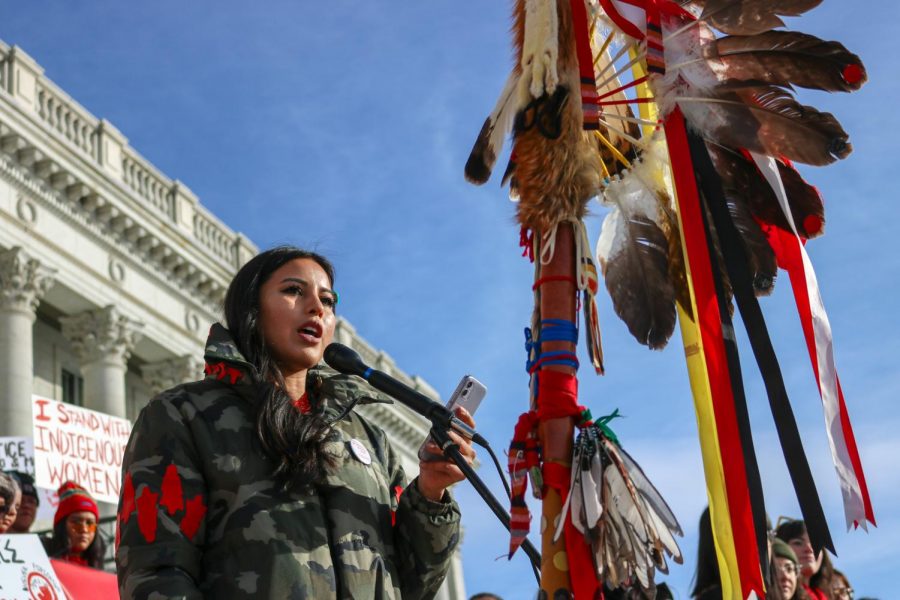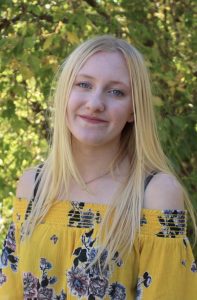Cushman: COVID-19 Illuminates the Inequities Indigenous People Have Faced for Centuries
Michelle Brown, campaign chair of the Missing and Murdered Indigenous Women organization, speaks at the Womxn’s March at the Utah state capitol on Saturday, Jan. 18, 2020.
August 3, 2020
The coronavirus outbreak has affected all our lives, but ethnically and racially diverse communities are facing the pandemic’s severest consequences. COVID-19 has had a disproportionate impact on indigenous populations specifically, in large part due to a lack of resources to combat it. While the pandemic has illuminated the lack of resources available to indigenous communities, it is hardly a unique incident. The disparities between indigenous communities and the rest of the nation are part of a pattern resulting from the U.S. government’s failure to address inequality on reservations.
A Lack of Resources
Living conditions on reservations are harsh. Reservations lack access to certain things that are built into other communities, like quality healthcare, housing and education. American Indians and Alaskan Natives live 5.5 fewer years than the average American – a grim statistic linked, of course, to the poor healthcare resources available on reservations. Receiving care can take weeks unless indigenous people are able to travel, sometimes several hours, to a hospital themselves. Reservations also have a severe housing shortage, with 30% of housing being overcrowded and 90,000 Native Americans living homeless or under-housed. Of the housing available on reservations, much of it lacks electricity and indoor plumbing. Schools on reservations are severely underfunded and struggle to find quality teachers.
These issues compound on each other. Poor access to healthcare affects Native American children’s education. In an article from Kaiser Health News, one Native American man explained how his young daughter “missed school for two weeks because they [couldn’t] get a doctor’s note to vouch that her head lice [had] gone away.” And inadequate housing can increase health risks in indigenous communities. On reservations, where many generations often live together in a small house, quarantining family members who test positive for COVID-19 can be an impossible task.
A Lack of Opportunity
Living on reservations denies indigenous people the opportunities available to many Americans. Reservations are often economically depressed and have high unemployment. Between 2009 and 2011, 25- to 54-year-old Native Americans were employed at a rate of just 64.7% – which was 13.4 percentage points lower than white Americans during the same years. Native Americans also have a harder time obtaining loans. Because of legal differences between reservations and the rest of the United States, loaners can’t always guarantee that contracts will be enforced, thus making them more hesitant to loan. These factors, combined with the housing shortage on reservations, make it difficult for Native Americans to become homeowners, one of the most important factors in establishing wealth. Wealth is also hard to develop because much of the property on reservations is communally owned. This fact means that there is little incentive for individuals to invest in the land or treat it with the care they would treat their own property — which in turn devalues reservation land and damages the local economy. Knowing this, it makes a lot of sense that poverty rates are higher among indigenous communities than the rest of the nation.
Native Americans also lack the same voice as other Americans in what the future of this country will look like. Voter suppression on reservations is a serious issue. An official address is necessary in order to vote in many states, but 50,000 homes and businesses in the Navajo Nation do not have a street address. And while reservations function differently than most of the country, our voting laws do not recognize those differences or allow accommodations that would let unaddressed Native Americans vote— which means indigenous people do not have an equal say in the education of their children and cannot vote for leaders who will listen to their needs.
The United States prides itself on affording equal opportunity to all of its citizens, but Native Americans are trapped in a cycle of limited economic mobility. For parents on reservations, there is no guarantee that their children’s lives will be better or more filled with opportunity because the long-standing barriers to opportunity are not being addressed.
Time for Change
Efforts to solve these problems have been few and far between as well as severely lacking. In 1934, after discovering that the United States was educating their students to suppress their “Indianness,” indigenous people were given control of their own education – but they received no resources to guarantee the quality of that education, leading to an educational disparity we still see today. The Voting Rights Act of 1965 helped mitigate suppression of the Native American vote, but indigenous communities still face barriers to voting, and the Supreme Court’s ruling in Shelby County v. Holder minimized the positive effects of the Voting Rights Act. Time and time again, efforts to repair the damage done to Native Americans has resulted in broken promises and disappointment. COVID-19 has shined a light on the disparities between indigenous communities and the rest of the nation by damaging both the health and economies of reservations. Now is the time to address those disparities.
Indigenous people deserve not only the right to live, they deserve to live a high quality life. The American dream is founded on the idea that anybody can be successful with hard work and determination. Reality is often much more complicated than that, but without trying to equalize the conditions between indigenous people and the rest of the country, equal opportunity will never truly exist.








